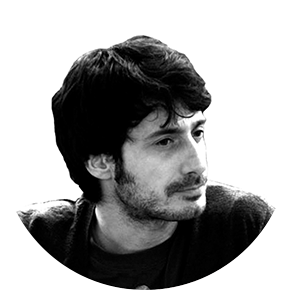Hugo Pratt, art by Origa, pen&ink+ pantone letraset, 2002 (printed on canvas, 2008, available)
Hugo Pratt, The Man From Venice. Conversation with the the last classic adventure cartoonist. Graziano Origa at Pratt’s home near
Lausanne, Switzerland in 1993. The artist chats about his influences
and his colleagues. Reportage published in The Comics Journal #169, July 1994.
HUGO PRATT (1927-1995). As the American adventure strips that inspired Pratt in his youth
degenerated and died out, he revitalized them in Europe and South
America by drawing or creating a variety of strips which matched, if
not surpassed, his models. The most famous of these strips are, of
course, the classic Corto Maltese stories. But Pratt did not mysteriously
spring out of nowhere; Corto Maltese was the culmination of a long
apprenticeship where Pratt was only one of a number of artists, and
Corto only one of many series, mostly unknown in the U.S., that
influenced one another.
"Devo dirti, Graziano, che quelli del
mondo dei fumetti, hanno sempre paura di me. Non so perché… Forse per
via degli occhi severi. Un emiro arabo invece, mi ha detto che quando
vorrò potrò andare a vivere in un’ala del suo castello" (hp)
GRAZIANO ORIGA: Is it reasonable to say that Hugo Pratt basically always does the same comic, sort of like Federico Fellini always makes the same movie?
HUGO PRATT: No, I don’t think that’s true. Maybe that
impression comes from the fact that my characters often meet, and move
from one story to the next. We find Lt. Tenton of the Desert Scorpions, Jungle Ann again in and in Corto Maltese.
It’s like playing a giant game of chess. A lesson I was taught by
Milton Caniff; he also often moved his pawns about the Dragon Lady
and Burma met and they became important as a result.
GRAZIANO: You often come back to Caniff in your conversation. Do you consider him your great teacher?
HUGO: I’m always talking about Caniff because of his extraordinary stylishness. He revolutionized comics.
GRAZIANO: Apart from Caniff, what other artists have influenced you?
HUGO: Lyman Young, of Tim Tyler’s Luck. Young was a
great African adventure storyteller and he made two generations dream.
He drew the most beautiful women in the history of comics, like
Lorilla or Queen Loana. They had personality, they had style, and they
were very sexy. As a kid in ’35, before I left for Ethiopia, I read L’Avventuroso which published another great artist that few remember: that was Will Gould, author of Red Barry and Bob Star.
It may have been him who gave me the desire to draw. Gould’s art was
unrivaled in its dynamism and modernism. Once, he wrote an introduction
to one of my things. After seeing my
art he sent me a letter, where he said that to him, it was like a boxer
looking for the knock-out punch. He said, “I see, Mr. Pratt, that
you’re not afraid to dip a pen or brush in a bottle of ink and throw
down a velvet-black line with the same confidence as a boxer launching
his attack.” That was a nice compliment! The comparison with a boxer
was to the point. I’ve kept that letter and I cherish it.
Gould died drunk, smoking a cigarette in bed. I’d looked for
him, and I’d paid for his trip from America to the Lucca Salon, but on
the phone, he asked me, “Who’s going to pay my trip from California to
New York?” At which I thought, “Man! He’s really a beggar!”
But he was one of the true masters, one of those who gave an
aristocratic elegance to comics. Like Alex Raymond, who, whith Flash Gordon, turned boys’ worlds upside down, making them dream of cloud cities.
GRAZIANO: And before them?
HUGO: Before them we must go back to Art Nouveau, to a great
artist like Windsor McCay. His Little Nemo, dreaming, winds up in
incredible worlds with giant flowers. He would get lost in a vase of
daisies, and these daisies would become a jungle.
GRAZIANO: You’re always quoting American authors.
HUGO: Yes. Looking at the Americans, we often forget to
point out that Americans have borrowed from us Europeans, from our
architecture, our poetry, our painting. If we wonder where Raymond
found a certain architecture, a certain design, we discover that he
looked at the spires of Gaudi, the architect of the Barcelona cathedral
who was never able to finish its façade. Not to mention the
Impressionists, from whom the Japanese have taken so much.
GRAZIANO: Who are your Italian colleagues whom you’ve been closest to or whom you admire?
HUGO: There are so many good ones. I’m grateful to Mario
Faustinelli because he’s the one who gave me the chance to be an
artist. Then I should mention Dino Battaglia, who was a poet of
drawing. Also skilful was Grazia Nidasio, who was ahead of everyone
else when she invented Valentina Mela Verde. She had a very elegant style, and her characters were
delightful. I cherish my memories of her; I always thought of her as a
good working pal.
GRAZIANO: Dino Battaglia and Grazia Nidasio. Those names take us back to the Corriere dei Piccoli in the ’60s.
HUGO: Yes, I was just back from Argentina. I remember that I went to the Corriere,
and presented myself to Carlo Triberti. Triberti wasn’t fit to be an
art director, he didn’t have the guts to make any changes. He
remembered the Corriere dei Piccoli as it was in his childhood,
and wanted to redo it that way. He looked at my pages, smoking his
pipe, and said “I’ll see what we can do.” I instantly realized that he
didn’t like them at all. Then I went to Giancarlo Francesconi, who was
the chief editor. Francesconi struck me as a modern guy; he was young,
just a little freaky, with a long beard. “Look,” I told him, “I need
work, but those guys in the other office are killing me… Can you give
me a hand?” He started to laugh and said “O.K., I’ll see to it.” And he
gave me work. There are people who help you in life. I’ve been given a
helping hand, and that’s why I feel it’s my duty to help younger
artists.
GRAZIANO: Ok dear, you had to fight further battles at the Corrierino…
HUGO: Yes, I’m a real fighter. But I often ended up empty-handed. Once there was a kind of insurrection at the Corriere della Sera,
because they wanted us to sign a fraudulent contract. I didn’t go
along, while all the others signed. The only one who sided with me was
Iris De Paoli. She was a great fighter, De Paoli. She was an
Argentine, and was very good at her little comic-strip theaters; they
were a little ‘commedia dell’arte’ in comics form.
GRAZIANO: In those years you did a great historical comic: Fanfulla’s Adventures.
HUGO: Fanfulla is important because it was a change
in my style. I’d adopted a much freer drawing style, compared to
before. I remember that some colleagues from the Corriere dei Piccoli
went to Triberti to complain that I was working too fast. I had to do
something on Florence, and the town, according to them, wasn’t really
seen. I had drawn three cypresses and a lane leading to a chapel. To
me, that was Tuscany.
GRAZIANO: Ok Hugo, before dinner, let’s discuss painting…
HUGO: We, the Italians, don’t know much about our own art. We think of Baroque painting, of the Neapolitan seicento,
unfolding into the 18th Century. There are the most beautiful paintings
of Neapolitan markets that nobody knows about. I can’t understand that
people speak so much of Van Gogh, Gauguin, Cézanne – definitely great
masters, don’t get me wrong – but one forgets to speak of the Italian macchiaioli*.
Think of Giovanni Fattori. The fact is that even art is subject to fashion.
Klimt and Egon Schiele came out because someone was smart enough to
make them come out. It was Vittorio Sgarbi – that one who’s always on TV
nowadays – who made Norman Rockwell known in Italy by organizinga show
of all the Saturday Evening Post covers. It was Sgarbi who
first began to talk of Rockwell as a great painter, when others had
always looked on him as a Sunday painter. But Rockwell has nothing to
envy from the Flemish artists.
GRAZIANO: Corto Maltese Magazine stopped publishing with the July issue, this year (1993)…
HUGO: Yes, after almost ten years… To make it, they should
have waited until October. The publishing house Rizzoli decided to
close up shop, figuring that it wasn’t worth losing any more money,
because they’d already lost a great deal. Nevertheless, of all the
slick magazines, Corto Maltese was the best. It was still
selling 16-17,000 copies, while the others were under 12 or 8,000. To
cancel a magazine like that, where every month great artists and great
writers were published, was like throwing away a part of culture. It’s
not by chance that everybody talks about it, everybody regrets it.
Rizzoli could have kept Corto afloat. They said that it was the
apple of their eye, but it turned out that the apple had gone sour. So
a cycle ends. And I still had to wrap up a story.
GRAZIANO: The last panel is meaningful…
HUGO: Yes, there’s a character who says “We shall all be on the street.”
*The macchiaioli were a group of 19th-century
Florentine and Neapolitan painters rather similar to the French
Impressionists. Giovanni Fattori (1825-1908) was their most famous
member.
Corto come un romanzo nuovo, Lizard, di Gianni Brunoro (La Stampa, Antonio Faeti, luglio 2008)
UP IMAGES CREDITS:
Hugo Pratt, photo by Joe Zattere, Lausanne, 1993
Graziano and Hugo, photo by Joe Zattere, Milano, Galleria Nuages, 1993
Graziano Origa Foundation





